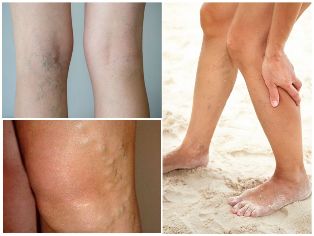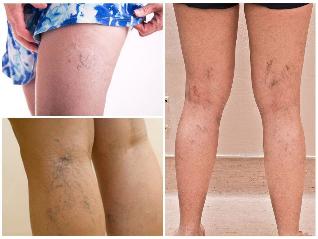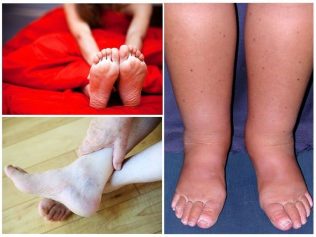Varicose veins of the lower extremities, and chronic is a disease that is characterized by the thinning of the venous walls, the increase of cardiovascular diseases are clear and the formation of knotty extensions.
The disease is diagnosed with 15-17% of the adult population. In adulthood, the disease is most frequently diagnosed in women, which is related to the hormonal reorganization in the body (menopause, pregnancy, menstruation).
Varicose veins of the veins is manifested wide of the clinic. The patients complain of the severity and discomfort in the extremities, rapid fatigue, swelling in the ankle, cramps in the night, that act in the blue veins. During the pathology on the background of the lack of adequate treatment leads to various complications.
Causes and risk factors varicose veins of the lower extremities

Varicose veins of the lower extremities in the majority of the paintings is the result of a genetic predisposition. The immediate cause: immaturity of functional valves in the veins and the underdevelopment of connective tissue element of the glasses. This causes increased load on the inside of the blood vessels and the appearance of varicose veins.
The etiology of obey to factors that are innate, that are associated with hypercoagulation – increase of the coagulation of the blood. At the bottom of the infraction form blood clots, which violates completely the blood flow in the legs, leading to pathological enlargement of the venous clear.
A frequent cause of development of the disease in women, hormonal of error. It is based on the change of the concentration of sex hormones in the blood. Is related to the onset of menopause and pregnancy.
Causes of varicose veins of the legs:
- The excess of weight. Obesity has mechanical impact on venous wall, especially, expressed this manifests itself in the bottom abdominal type. As a result, the patient increases the other venous pressure;
- Diabetes mellitus. A result of complex disorders of the metabolic processes related to the constant of sugar in the blood of the relative insufficiency of insulin there is a decrease in the elasticity of the venous walls, thereby contributing to its extension;
- The alcohol dependence. The alcoholism, the body does not have enough fluid, the blood becomes thicker, which leads to the alteration of the circulation of the blood;
- Professional factors permanently be in a vertical position, the excess physical load, sedentary lifestyle);
- The use of uncomfortable shoes, for example, high heels;
- Serious pathology of the cardiovascular system, which manifests itself in the failure of the circulation of the blood.
Lead to varicose veins of the feet can chronic pathology of the genital organs. In particular, the inflammation of the prostate in men and appendices of the women.
The mechanism of disease development is based on the participation in the inflammatory process of small veins that causes swelling and difficulty in blood flow.
The signs and symptoms of the varicose disease
Varicose veins veins of the legs manifests itself with different symptoms. We will begin with external events. Well, more of an indication of clear evidence about the occurrence of the disease is the conversion of a contour and shape subcutaneous and the vessels of the legs. It is manifested by swelling, uzelkovoe thickening. The vessels are dark in color, are identified setochki and the toothed wheel.
Ulcers food webs on the feet are treated in two parts. Part of the doctors classified the wounds of the symptoms, while others to the complications of the pathology, the proof of the last one – the execution of the stage of pathological process.
Classification of varicose veins of the legs
Varicose veins of the feet is often diagnosed to mature women that men of that age. At the early age of a disease of the young and manifests with the same frequency. According to the classification of the disease is primary and secondary in nature. In the first case, the changes relate to the surface waters of the vessels. The violation of the structure and the deep structure of the glasses are missing.
Secondary varicose veins is one of the complications of the pathology of deep veins, so that observed changes in the surface of the vessels of the legs. This pattern is manifested on the background of congenital malformations, abnormalities of the venous system, and also as a consequence of phlebothrombosis.
Also the disease is classified on clinical forms. They lead to varicose veins side the vessels thighs and hips, reticular shape, and varicose veins telangiectasias. Keep in mind these forms of read more:
- Varicose veins side veins is as independent of the disease, and in combination with other pathologies. The return of the venous fluid occurs in a deep vein through a subcutaneous and around the vessels.
- Mesh (lattice form) manifests itself as independent of the pathology. It does not lead to venous insufficiency, it is only a cosmetic defect.
- Varicose veins telangiectasias are also an aesthetic defect.
In recent years, surgeons distinguish venous insufficiency of the idiopathic form. It is characterized by the increase of the venous energy, when this express the causes of that failure cannot be detected. The clinical manifestations of the pathology is not different from the classical of the clinic.
In the stage and degree of varicose veins

Varicose veins of the vein in the leg varies depending on the stage and the grade. For the establishment of the same taking into account the clinical the patient. A chronic disease is of several stages, which have certain differences:
| The stage of | The feature of the |
| The compensation of the | Pain syndrome weakly expressed or not. The patients complain of the discomfort of the legs due to the long run. It is observed the presence of vascular setochki in the skin, is periodically manifested by swelling in the ankle, it passes quickly after the break. |
| Subcompensation | When the visual inspection of the lower limbs of the patient visible in vienna with a clear. Patients have a lot of complaints. In particular, they complain of persistent pain bowing of the nature, increased fatigue, heaviness in the legs. Night, often, contractions of the muscles, "at the goose bumps on the skin. Are you notice any swelling, after a night of sleep in 90% of cases, and to yourself. |
| Decompensation | More heavy of the stage of varicose veins. Changes occur on the part of the epidermis. Becomes excessively dry, falling hair on the legs. In addition, it reveals the hyper-pigmentation which leads to abnormal thickening of the subcutaneous tissue. The cracks and scratches in the legs heal a lot of time, are able to transform into ulcers trophic. The feet are swollen constantly, rest and sleep do not help. Swelling have the property of elevation above the feet. |
When the girl or the guy come to the doctor with complaints of the following symptoms, the doctor performs a visual inspection, that designates the laboratory analysis and instrumentation methods of diagnosis. From the results obtained speak of the way in the stage and degree of the pathology.
The degree of varicose veins of the legs are defined by numbers. Zero (0) the clinic has not been identified, the external changes do not exist; I – swelling, tiredness of the limbs; II – constant of the swelling, accompanied by hyper-pigmentation, aberrant stamp of the subcutaneous tissue; III – pain that does not pass swelling of the legs, ulcers trophic.
The complications of venous insufficiency
Varicose veins – chronic incurable disease, so the treatment pursues certain objectives to stop the progression and avoid complications. If the treatment assigned incorrectly or the patient does not ask for help from a specialist, will develop complications of the disease.
Thrombophlebitis – inflammation of the walls of the veins if there is a clot of blood. In the inflammatory process may be nearby blood vessels and soft tissues. Distinguish various forms. Is acute (lasts around 30 days), subacute – duration up to six months and chronic type.
Migratory thrombophlebitis is rare. It is characterized by inflammation that occurs in various areas of the city of vienna, it passes quickly.
Symptoms include:
- Visually it is visible, an accurate contour to the inflamed vessel.
- Acute pain syndrome, palpation and the pain is more strong.
- Swollen nodules that protrudes above the skin.
- The local elevation of the temperature.
Thrombophlebitis varicose veins of the legs can lead to other complications. For example, periphlebitis – inflammation of the surrounding tissues, wet gangrene of the extremities, thrombosis of the deep veins. When the distribution of the inflammation is manifest the complications that go beyond the extremities – thromboembolism, and sepsis.
Thrombosis of the deep veins of the common complication varicose veins of the legs. The pathology is characterized by the formation of a dense formation of a blood clot, which fully or partially blocks a blood vessel, which violates the full circulation of the blood. This high index of suspicion is no risk of death due to the separation of a blood clot.
Ulcers trophic appear in severe cases. Often binds to the infection, which aggravates the box clinical. The injuries can affect not only the fabric, and the deeper layers of muscles. Heal continuous. It requires a comprehensive treatment.

The veins varicosasNaya eczema is characterized by symptoms such as:
- Inflammatory hyperpigmentation of the skin purple or bright red;
- Form microvesicles, which are self-revealing;
- Swelling of the feet;
- Itching in the skin, which may occur permanently;
- Crying, which after drying is covered with a scab;
- Abnormal thickening of the epidermis.
The veins varicosasNaya eczema may go on to chronic during, which manifests itself sclerotherapy of the epidermis and the subcutaneous tissue.
The accession of the infection eczema is complicated trophic pests.
Conservative treatment of varicose veins of the legs
Conservative therapy varicose veins includes the medication and the use of a compression of the clothes. Close the knitted fabric is different from the kind of compression and the destination times for the prevention and treatment of pathology. Stockings, tights and socks must pick up the doctor taking into account specific features. Only the correct clothing gives the desired result.
Medicines are prescribed. Ideal effective medication that affect all the pathological elements of the disease, does not exist. It is recommended that the use of the system of medicines of the tablet and the local resources of gels, balms, creams and ointments.
In addition, prescribed physical therapy procedures – magnetotherapy, electrophoresis; special gymnastics. You can use home remedies – recipes of herbs help reduce the severity of the symptoms.
Sometimes it is recommended to hirudotherapy – treatment with leeches.
The methods of surgical treatment
When conservative ways to give a small result, the disease progresses, it is recommended to perform the operation. Often practiced sclerotherapy. In vienna is injected with a special substance that adheres to surprised with the glass. With the passage of time, is replaced by connective tissue.
The radiofrequency ablation. With this intervention is carried out "welding" of a blood vessel (the sick), through a probe that emits sound waves. The probe heats the wall, which causes stenosis. After the intervention of a time you need to take the compression garment.
Selection of a method to help the patient through the surgery depends on many criteria. The doctor takes into account the phase of the disease, the wellness of the patient, the presence of chronic, which may be a contraindication to the completion of the intervention.
Other types of surgery:
- Phlebectomy – the doctor removes the affected veins and vessels. Through a small puncture in the skin to introduce a tool with a hook through which to pull the glass. This technique is combined – use surgery and the use of laser.
- The most effective form of treatment is considered to be a coagulation laser of the veins of the lower extremities. The methodology of execution of the operation is performed with a minimum of cuts and wounds. Through a small incision in the skin into a container introduces more subtle accounting that emits wave lengths of the frequency of the desired. In the area of influence is observed warming. The wall accretion, which allows you to level the problem.
Peeling is done through the small tube is injected through an incision and stick the affected part of vienna. Cryostripping – in the container to introduce liquid nitrogen, which leads to the degradation of the area, followed by non-functionality.
The prevention of the
The preventive measures are of great importance. Favorable the prognosis depends not only on the successful appointment of a doctor and carried out the treatment, but also of the patient, it is he who has to change his style of life, follow the recommendations of flebologa.
So, you will have that continual use of the compression underwear or medical tape on the limb elastic bandage. By feedback from patients, the first option is more convenient. Even after the surgical intervention requires constant physical activity, but without an excessive load on the body.
During sleep it is recommended that the feet give a euphoric position. To do this, the tips on the pillow or minimized the blanket. If the work is related to the constant or permanent seat, every 60 to 80 minutes, you should do a little training to speed up the circulation of the blood in the body.
Women are recommended to stop using high-heeled shoes. The maximum heel height should be 5 see to All the patients it is necessary to pick a comfortable shoes, to withdraw from the clothes, which puts pressure on the limbs.
Varicose veins in the legs – a serious disease, which requires a multilateral approach in the treatment. Only the effect of integrated, compound medications, compression clothing, physiotherapy, motor activity and nutrition will lead to a positive outcome and the support of the remission.






































